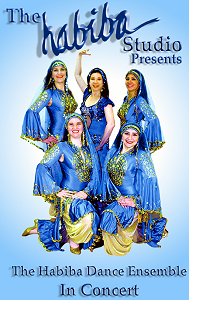










The Habiba Dance Ensemble in Concert
by Farasha by Nikki
On Aug. 23, 2003, the City of Brotherly Love had the unique good fortune to experience a truly memorable evening: a concert by the Habiba Dance Ensemble, in honor of Dr. Mo Geddawi’s 5th workshop appearance in Philadelphia. Habiba presented this special program at the International House in Philadalphia, where the workshops have been hosted for the past few years. That concert has been recorded and preserved in the newly released video, The Habiba Dance Ensemble in Concert. Ten dancers and their mentor, Habiba, offer up over an hour of pure magic in one of the most enjoyable concert videos I have had the pleasure to watch.
The program featured a wonderful diversity of ethnic styles, from Egypt, Nubia and Tunisia, to the Moorish influence of Spain, and Turkish gypsy flavors. The strong troupe performances captured the distinct essence of each portrayed region and style of Middle Eastern Dance. Each dance was so different in look and spirit, yet notably, one talented choreographer had created them all: Habiba. The only exceptions were the seven choreographies by dance master and guest instructor, Dr. Mo Geddawi, featured in the second part of the concert video.
The video follows the exact sequence of the performances, beginning with the Trakya Karsilama, an interpretation of a traditional Turkish song from Thrace. Although audiences may be more familiar with Habiba’s interpretation of Egyptian and Andaulsian dance, she created a delightful choreography to this Turkish gypsy-inspired number. Basic costuming elements consisting of black leotards and colorful, ruffled skirts and shawls lent a simple, unpretentious charm to the dance, which was playful and entertaining.
A Night in Damascus was a fascinating fusion of contemporary Arabic jazz with medieval Andalusian music, inspired by an anonymous medieval Arabic poem. Habiba entered in a slinky black gown with a flounced bottom- the only color a blood-red rose in her hair. Her electrifying dance was a Moorish blend of the distinct Andalusian style with its artful and elegant Spanish arms, and the more earthy Arabic style- punctuated by sudden, heated moments when a jazz trumpet wailed, and Habiba responded with passionate and sultry movements. Old and new flavors were blended seamlessly, with a creativity, grace and elegance that define much of Habiba’s work today.
Wearing the traditional melia and yarn belts, 6 dancers performed the Addala Ya Addala, a Tuinisian raqs-al-Maharem, or scarf dance. An historic note here: Originally a flirtatious café dance, the scarf dance took on a new meaning in the mid-twentieth century, (1956?) when the dancers adopted the red and white scarves during the Tunisian struggle for independence. Red and white were the colors of the then-secret new Tunisian flag. Habiba’s choreography was a lively interpretation of Tunisian-style dance, characterized by twisting hip movements, allowing the yarn tassels of the belts to swing back and forth, emphasizing the hips. Her staging interwove the dancers in interesting patterns across the floor, keeping the dance in constant motion.
Saidi Suite was next, with music by Metkal Kanawi. This pleasing tableau was a medley of dances from Upper Egypt, including the Saidi Raqs al Asaya (cane dance) and Ghawazi (Egyptian Gypsy) style. The set began with the Raqs al Asaya duet with dancers in turquoise hagallah-style costumes, demonstrating a skillful dexterity with their twirling canes. The music is one of my favorite Metkal numbers; and I’ve seen it performed several times in the past. Habiba’s solid choreography seems as fresh today as it did years ago, when I first encountered it.
The cane dance was followed by Habiba’s solo to the earthy Saidi rhythm. Wearing a simple beledi dress (with some interesting cutouts!) her performance was a saucy, carefree and witty interpretation of this folkloric style, and she related to the audience with ease and poise. It was most probably my favorite performance of the show!
The Saidi Suite ended with a finale that included the distinctive Ghawazi style, with its constant, rapid shimmies, zill-playing and characteristic back-to-back circling. The sparkly/fringy black beledi dresses and long, gold-fringed belts emphasized the continuous motion of the hips in the dance. The number was reminiscent of the rare and wonderful film footage of the Banat Maazin Ghawazee, documented by both Morocco and Aisha Ali.
Nubian Suite. According to the video notes, Nubian people traditionally from the area between Aswan and Khartoum, have a style of music and dance that is partly Arabic, partly African. Their sense of community in the face of their dislocation by the High Dam’s Lake Nasser is the inspiration for this piece. For this number, six dancers entered, holding their baskets high above their heads and wearing colorful, cotton print dresses. There was a stately, almost solemn quality to the dance at first. Then, as they laid the baskets down, the mood contrasted quickly to one of energy, strength and determination.
In the Malaya Dance, Habiba explains that the women of Alexandria were famous for their flirtatious manipulation of their Malaya (the urban style veil that was wrapped around the body for modesty on the street). Alexandria girls, she says, just want to have fun! That was abundantly clear as the 4 dancers entered in their ruffled, flounced and brightly-color satin dresses, with the characteristic raised hem on one side. They proceeded to tease the audience in a dance that was sophisticated, sassy and fun.
The first part of the program ended with Habiba’s lovely performance to Alf Leya Wa Leyla, a thousand and one nights. In a glittering green Oriental costume, her dramatic movements beautifully complemented this timeless classic, one of the most gorgeous pieces of Middle Eastern music, and fitting finale to Act One.
In the second part of the program, troupe members got the chance to showcase their own, individual artistry in excerpts from seven of Dr. Mo’s choreographies taught over the past several years at the annual Philadelphia workshop. "La Batta" (the duck) with its playful mimicking gestures, performed by Helen Driggs in a "fellahin" dress, was lighthearted and entertaining. Floating a pink veil, Angela was a graceful image in swirling pink and white as she performed to the classic Oriental dance piece, "Layali Zaman." Then Ilena took the stage in a flashy, alluring black and gold beledi dress in a lively choreography to "Rennet al Kholkhal." Hayet was next in a lovely green-fringed bedlah, performing "Ishta" with energy and charm. Tamarra in turquoise followed doing wonderful justice to the scintillating "Helwa al Leba Di. Galila danced with a dash of playfulness to "Tabeloha" Finally, Habiba charmed us once again with "Raqs Saidi", a perfect ending to a superb evening of dance.
For those of us fortunate enough to see this show- and for those who missed it- the entire concert is now available on VHS tape. This is one video definitely worth adding to your dance library! The concert is professionally taped and edited; each number is also introduced by a short textual explanation of the dance style. It’s a joyful testament to creativity of style, solid dancing, good staging and superb choreography. The Habiba Dance Ensemble in Concert is a pleasure to own!
www.Raqs-Sharqi.com
Habiba Dance Ensemble was founded in 1983 by the dancer and teacher Habiba (USA). This performance video was recorded at the International House of Philadelphia in August 2003. For the first part of the concert, the dances were choregraphed by Habiba. In the USA, Habiba is renowned for her understanding of the dance styles in the Middle East. The video also contains seven dances choreographed by Dr Mo. Geddawi who was the co founder of "Reda Dance Troupe" with Mahmoud Reda (read an article and an interview about his work).
This video has good sound and picture quality, with steady camerawork. It has been edited really well. It seems to be have been recorded by one, or possibly two video camera seated in the audience. All the performers are clearly viewable at all times. I really like the way the video has been put together - before each choreography, notes flash up with the title of the song and a brief explanation of each dance. This is a wonderful touch.
This video features a fantastic, wide variety of dance styles from right across the Middle East and North Africa. It contains solo, duet, and group choreographies. Habiba performs three solos on this video. A lot of thought has gone into the running order of the dances so you see something different each time. This meant that this video really held my attention all the way through to the end. The traditional choreographies on this video are excellent, I loved the the scarf dance choreography from Tunisia in particular. All the choreographies have been put together in the style and with the steps, and the correct music from the region the dance is originally from, with the correct costume components and props, resulting in really authentic dances, with good use of the stage and formation. The dancers are all really well rehearsed. The running order of this video is: 1) "Traka Karsilama" - interpretation of a traditional Turkish song from Thrace (group); 2) "On a Marvellous Night" - Arabic jazz fusion with medieval Andalusian music (solo); 3) "Addala Ya Addala" - traditional Tunisian scarf dance (group); 4) "Saidi Suite" - containing three dances, duet with cane; solo; and a Ghawazi group choreography; 5) "Nubian suite" (group); 6) "Malaya Dance" (group); 7) Elf Leyla Wa Leyla - classical oriental (solo); 8) "Tribute to Dr. Mo Geddawi" - seven solo choreographies danced by members of the Habiba Ensemble - "Batta"; "Layali Zaman" (veil); "Rennet Al Khol Khal"; "Ishta"; "Helwa El Leba Di"; "Tabellolha" and "Raqs Saidi".
This review reprinted from www.raqs-sharqi.com.


Habiba Dance Ensemble Links Videos
Website design by Lesley Ashmore and Helen Driggs.
